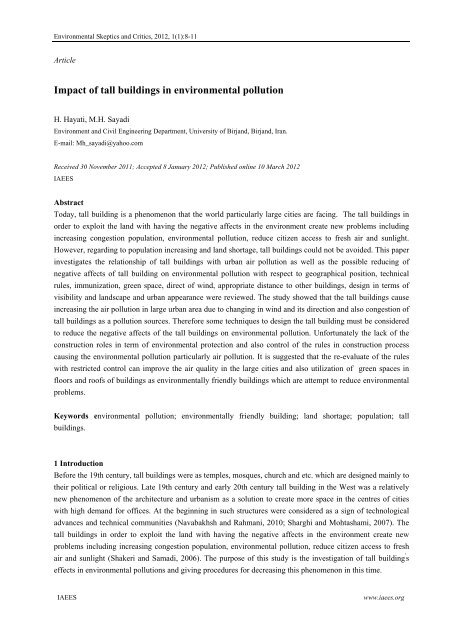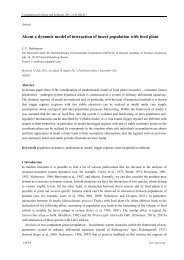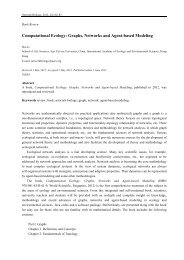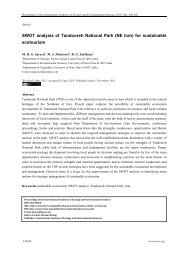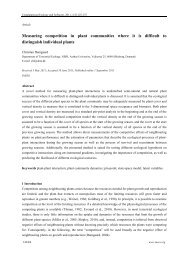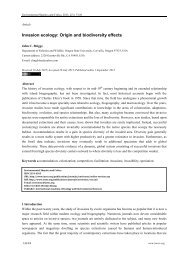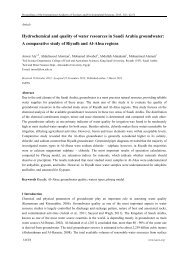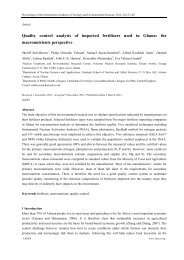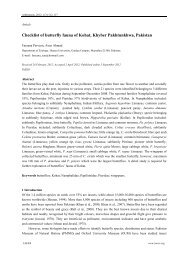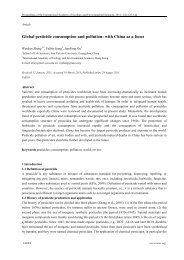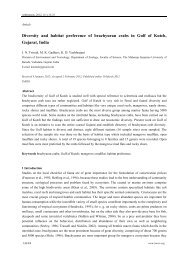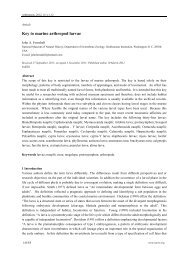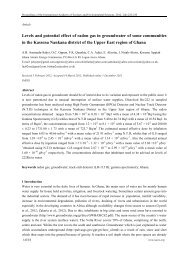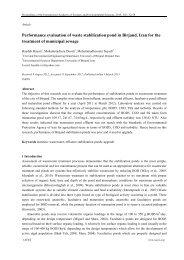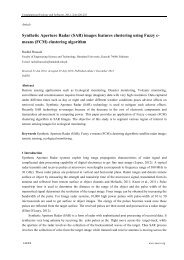Impact of tall buildings in environmental pollution
Impact of tall buildings in environmental pollution
Impact of tall buildings in environmental pollution
You also want an ePaper? Increase the reach of your titles
YUMPU automatically turns print PDFs into web optimized ePapers that Google loves.
Environmental Skeptics and Critics, 2012, 1(1):8-11<br />
Article<br />
<strong>Impact</strong> <strong>of</strong> <strong>tall</strong> <strong>build<strong>in</strong>gs</strong> <strong>in</strong> <strong>environmental</strong> <strong>pollution</strong><br />
H. Hayati, M.H. Sayadi<br />
Environment and Civil Eng<strong>in</strong>eer<strong>in</strong>g Department, University <strong>of</strong> Birjand, Birjand, Iran.<br />
E-mail: Mh_sayadi@yahoo.com<br />
Received 30 November 2011; Accepted 8 January 2012; Published onl<strong>in</strong>e 10 March 2012<br />
IAEES<br />
Abstract<br />
Today, <strong>tall</strong> build<strong>in</strong>g is a phenomenon that the world particularly large cities are fac<strong>in</strong>g. The <strong>tall</strong> <strong>build<strong>in</strong>gs</strong> <strong>in</strong><br />
order to exploit the land with hav<strong>in</strong>g the negative affects <strong>in</strong> the environment create new problems <strong>in</strong>clud<strong>in</strong>g<br />
<strong>in</strong>creas<strong>in</strong>g congestion population, <strong>environmental</strong> <strong>pollution</strong>, reduce citizen access to fresh air and sunlight.<br />
However, regard<strong>in</strong>g to population <strong>in</strong>creas<strong>in</strong>g and land shortage, <strong>tall</strong> <strong>build<strong>in</strong>gs</strong> could not be avoided. This paper<br />
<strong>in</strong>vestigates the relationship <strong>of</strong> <strong>tall</strong> <strong>build<strong>in</strong>gs</strong> with urban air <strong>pollution</strong> as well as the possible reduc<strong>in</strong>g <strong>of</strong><br />
negative affects <strong>of</strong> <strong>tall</strong> build<strong>in</strong>g on <strong>environmental</strong> <strong>pollution</strong> with respect to geographical position, technical<br />
rules, immunization, green space, direct <strong>of</strong> w<strong>in</strong>d, appropriate distance to other <strong>build<strong>in</strong>gs</strong>, design <strong>in</strong> terms <strong>of</strong><br />
visibility and landscape and urban appearance were reviewed. The study showed that the <strong>tall</strong> <strong>build<strong>in</strong>gs</strong> cause<br />
<strong>in</strong>creas<strong>in</strong>g the air <strong>pollution</strong> <strong>in</strong> large urban area due to chang<strong>in</strong>g <strong>in</strong> w<strong>in</strong>d and its direction and also congestion <strong>of</strong><br />
<strong>tall</strong> <strong>build<strong>in</strong>gs</strong> as a <strong>pollution</strong> sources. Therefore some techniques to design the <strong>tall</strong> build<strong>in</strong>g must be considered<br />
to reduce the negative affects <strong>of</strong> the <strong>tall</strong> <strong>build<strong>in</strong>gs</strong> on <strong>environmental</strong> <strong>pollution</strong>. Unfortunately the lack <strong>of</strong> the<br />
construction roles <strong>in</strong> term <strong>of</strong> <strong>environmental</strong> protection and also control <strong>of</strong> the rules <strong>in</strong> construction process<br />
caus<strong>in</strong>g the <strong>environmental</strong> <strong>pollution</strong> particularly air <strong>pollution</strong>. It is suggested that the re-evaluate <strong>of</strong> the rules<br />
with restricted control can improve the air quality <strong>in</strong> the large cities and also utilization <strong>of</strong> green spaces <strong>in</strong><br />
floors and ro<strong>of</strong>s <strong>of</strong> <strong>build<strong>in</strong>gs</strong> as environmen<strong>tall</strong>y friendly <strong>build<strong>in</strong>gs</strong> which are attempt to reduce <strong>environmental</strong><br />
problems.<br />
Keywords <strong>environmental</strong> <strong>pollution</strong>; environmen<strong>tall</strong>y friendly build<strong>in</strong>g; land shortage; population; <strong>tall</strong><br />
<strong>build<strong>in</strong>gs</strong>.<br />
1 Introduction<br />
Before the 19th century, <strong>tall</strong> <strong>build<strong>in</strong>gs</strong> were as temples, mosques, church and etc. which are designed ma<strong>in</strong>ly to<br />
their political or religious. Late 19th century and early 20th century <strong>tall</strong> build<strong>in</strong>g <strong>in</strong> the West was a relatively<br />
new phenomenon <strong>of</strong> the architecture and urbanism as a solution to create more space <strong>in</strong> the centres <strong>of</strong> cities<br />
with high demand for <strong>of</strong>fices. At the beg<strong>in</strong>n<strong>in</strong>g <strong>in</strong> such structures were considered as a sign <strong>of</strong> technological<br />
advances and technical communities (Navabakhsh and Rahmani, 2010; Sharghi and Mohtashami, 2007). The<br />
<strong>tall</strong> <strong>build<strong>in</strong>gs</strong> <strong>in</strong> order to exploit the land with hav<strong>in</strong>g the negative affects <strong>in</strong> the environment create new<br />
problems <strong>in</strong>clud<strong>in</strong>g <strong>in</strong>creas<strong>in</strong>g congestion population, <strong>environmental</strong> <strong>pollution</strong>, reduce citizen access to fresh<br />
air and sunlight (Shakeri and Samadi, 2006). The purpose <strong>of</strong> this study is the <strong>in</strong>vestigation <strong>of</strong> <strong>tall</strong> build<strong>in</strong>g ' s<br />
effects <strong>in</strong> <strong>environmental</strong> <strong>pollution</strong>s and giv<strong>in</strong>g procedures for decreas<strong>in</strong>g this phenomenon <strong>in</strong> this time.<br />
IAEES<br />
www.iaees.org
Environmental Skeptics and Critics, 2012, 1(1):8-11<br />
9<br />
2 Air Pollution Around Tall Build<strong>in</strong>g<br />
Regard<strong>in</strong>g to the importance roles <strong>of</strong> <strong>build<strong>in</strong>gs</strong> <strong>in</strong> <strong>environmental</strong> <strong>pollution</strong> particular air <strong>pollution</strong>, Abbaspour<br />
and Behjo (2000) studied on distribution <strong>of</strong> Particulate Matter (PM) and CO concentrations besides the<br />
build<strong>in</strong>g and also <strong>in</strong> different heights <strong>of</strong> build<strong>in</strong>g. Their research was conducted <strong>in</strong> a build<strong>in</strong>g with 27 floors.<br />
The results showed the identification and evaluation <strong>of</strong> <strong>pollution</strong> distributed around the build<strong>in</strong>g will help to<br />
design eng<strong>in</strong>eers choos<strong>in</strong>g the best position <strong>of</strong> w<strong>in</strong>dows regard<strong>in</strong>g to m<strong>in</strong>imal contact with polluted air. It also<br />
revealed that the average concentration <strong>of</strong> CO was <strong>in</strong>creas<strong>in</strong>g from the lowest po<strong>in</strong>t <strong>of</strong> the build<strong>in</strong>g up to about<br />
6-9 floor then with irregular process gradually decreases. It may be due to higher w<strong>in</strong>d speed <strong>in</strong> the upper<br />
edges <strong>of</strong> the build<strong>in</strong>g which causes decreas<strong>in</strong>g the <strong>in</strong>tensity <strong>of</strong> <strong>pollution</strong>. However the <strong>in</strong>creas<strong>in</strong>g height from<br />
the ground is caused <strong>in</strong>creased distance from the primary <strong>pollution</strong> sources (cars) but the volume <strong>of</strong> <strong>pollution</strong><br />
is not associated with the distance from <strong>pollution</strong> sources. It may be due to some factors such as local w<strong>in</strong>ds<br />
and eddy currents around the build<strong>in</strong>g, caus<strong>in</strong>g accumulation <strong>of</strong> <strong>pollution</strong> and scatter them <strong>in</strong> some parts <strong>of</strong> the<br />
build<strong>in</strong>g, therefore, the air flow around the <strong>build<strong>in</strong>gs</strong> which is affected by many factors such as local streams,<br />
location and type <strong>of</strong> <strong>in</strong>s<strong>tall</strong>ation <strong>of</strong> w<strong>in</strong>dows is more important than <strong>pollution</strong> sources for distribution <strong>of</strong><br />
<strong>pollution</strong> parameters (Abbaspour and Behjo, 2000).<br />
3 Role <strong>of</strong> Build<strong>in</strong>gs <strong>in</strong> Climate<br />
Tall <strong>build<strong>in</strong>gs</strong> have a special impact and play an important role on climate or weather and environment which<br />
chang<strong>in</strong>g climate factors are mostly related to sunsh<strong>in</strong>e and w<strong>in</strong>d.<br />
3.1 Sunsh<strong>in</strong>e<br />
Sets high and dense <strong>build<strong>in</strong>gs</strong> to benefit from sun exposure are more restricted, because the shadows on their<br />
adjo<strong>in</strong><strong>in</strong>g <strong>build<strong>in</strong>gs</strong> as lower floors <strong>of</strong> <strong>tall</strong> <strong>build<strong>in</strong>gs</strong> as well as short <strong>build<strong>in</strong>gs</strong> are more <strong>in</strong> the shade.<br />
3.2 W<strong>in</strong>d flaw<br />
Survey <strong>of</strong> w<strong>in</strong>d flow <strong>in</strong> the urban area, especially with<strong>in</strong> <strong>tall</strong> build<strong>in</strong>g <strong>in</strong> two terms is very important:<br />
(1) Tall <strong>build<strong>in</strong>gs</strong> can cause undesirable <strong>in</strong>tensification <strong>of</strong> w<strong>in</strong>d flow <strong>in</strong> urban streets and open spaces<br />
(square).<br />
(2) On the other hand also have the ability to avoid w<strong>in</strong>d flow <strong>in</strong> urban spaces.<br />
In both cases, depend<strong>in</strong>g on various conditions, w<strong>in</strong>d flow or w<strong>in</strong>d stagnation could be favourable or not<br />
favourable. So <strong>in</strong> the polluted urban environments, <strong>in</strong>creased air flow to prevent stagnation and accumulation<br />
<strong>of</strong> the <strong>pollution</strong> is very useful while for pedestrian and visitors <strong>in</strong> open space are undesirable and<br />
uncomfortable.<br />
Generally <strong>build<strong>in</strong>gs</strong> depend<strong>in</strong>g on how their exposure to w<strong>in</strong>d flow, create dual effects <strong>in</strong>clud<strong>in</strong>g w<strong>in</strong>d flow<br />
is <strong>in</strong>creased or recession. Flow rate set po<strong>in</strong>ts with a recession <strong>in</strong> the w<strong>in</strong>d and the <strong>tall</strong> <strong>build<strong>in</strong>gs</strong> can deal with<br />
the accumulation <strong>of</strong> air <strong>pollution</strong> on residents to stop. Also, despite these po<strong>in</strong>ts can reduce the adverse<br />
<strong>environmental</strong> w<strong>in</strong>d flow can be exploited.<br />
If the distance between <strong>build<strong>in</strong>gs</strong> is appropriate, the aerodynamic areas <strong>of</strong> each build<strong>in</strong>g to act <strong>in</strong>dividually<br />
and not <strong>in</strong>terfere <strong>of</strong> w<strong>in</strong>d flow <strong>in</strong> these areas, the impact <strong>of</strong> <strong>tall</strong> build<strong>in</strong>g on w<strong>in</strong>d flow reaches m<strong>in</strong>imum level.<br />
But if the distance between <strong>build<strong>in</strong>gs</strong> is not appropriate the aerodynamic take effect, whatever set is denser and<br />
more compact, the behaviours <strong>of</strong> w<strong>in</strong>d flow and the impact on the speed are required more complex analysis<br />
and apparent negative occurs (Masoud, 1997).<br />
4 Effects <strong>of</strong> Tall Build<strong>in</strong>g <strong>in</strong> Environmental <strong>Impact</strong><br />
Rahbar (2002) reported that the important <strong>of</strong> <strong>environmental</strong> impact assessment on high density build<strong>in</strong>g <strong>in</strong><br />
Tehran. In <strong>environmental</strong> impact assessment and high build<strong>in</strong>g density, consider<strong>in</strong>g the economic issue, social<br />
IAEES<br />
www.iaees.org
10<br />
Environmental Skeptics and Critics, 2012, 1(1):8-11<br />
and <strong>environmental</strong> balance it is also important. In this regard, optimal use <strong>of</strong> height <strong>in</strong> the form <strong>of</strong><br />
implementation projects and high build<strong>in</strong>g density can grow <strong>in</strong> the direction <strong>of</strong> social, economic and<br />
<strong>environmental</strong> welfare <strong>of</strong> city residents is effective. This po<strong>in</strong>t is essential to mention that the projects <strong>of</strong> high<br />
build<strong>in</strong>g density hav<strong>in</strong>g negative <strong>environmental</strong> impacts like other development projects. So it should be run<br />
with the <strong>in</strong>tegration <strong>of</strong> <strong>environmental</strong> considerations which are able to remove or reduce adverse effects as<br />
well as accelerate the positive effects on susta<strong>in</strong>able urban development shall provide (Rahbar, 2002).<br />
5 Plants Role <strong>in</strong> Reduc<strong>in</strong>g Air Pollution<br />
Vertical green spaces have been the perspective <strong>of</strong> design eng<strong>in</strong>eers. Experts believe that the role <strong>of</strong> vertical<br />
green spaces improve the urban landscape as well as reduc<strong>in</strong>g air <strong>pollution</strong> and noise <strong>pollution</strong>. Sharghi and<br />
Mohtashami reported that more than 800 ro<strong>of</strong>s with green space has been counted <strong>in</strong> Germany and used as a<br />
field production <strong>of</strong> vegetables and edible fruits. Ro<strong>of</strong> gardens help absorb heat and cause lower the<br />
temperature <strong>in</strong> summer and higher temperature <strong>in</strong> w<strong>in</strong>ter <strong>in</strong>side the build<strong>in</strong>g, consequently reduc<strong>in</strong>g the energy.<br />
In addition plants can balance temperature and humidity and also able to absorb toxic gases such as palm green<br />
leafy tillers <strong>in</strong> each hour absorb and remove 20 mg <strong>of</strong> ammonia <strong>in</strong> the air. Therefore, the role <strong>of</strong> <strong>environmental</strong><br />
plants and green spaces <strong>in</strong>clud<strong>in</strong>g, release oxygen <strong>in</strong> the air, cool<strong>in</strong>g hot air, shadows and air filtration (Sharghi<br />
and Mohtashami, 2007).<br />
6 Skeptics<br />
The lack <strong>of</strong> attention to <strong>environmental</strong> issues <strong>in</strong> terms <strong>of</strong> construction, result<strong>in</strong>g the occurrence <strong>of</strong><br />
<strong>environmental</strong> <strong>pollution</strong>, especially air <strong>pollution</strong> <strong>in</strong> large cities <strong>of</strong> many countries like Iran. Therefore it is<br />
necessary to re-evaluate the legislation construction and str<strong>in</strong>gent regulation <strong>in</strong> order to enforce these laws by<br />
rely<strong>in</strong>g on the core pr<strong>in</strong>ciples <strong>of</strong> <strong>environmental</strong> criteria.<br />
7 Conclusions<br />
Tall <strong>build<strong>in</strong>gs</strong> affect on the air flow and <strong>pollution</strong> parameters is not distributed consequently the air <strong>pollution</strong><br />
<strong>in</strong> cites are <strong>in</strong>creas<strong>in</strong>g. In addition to obstruction <strong>of</strong> visibility and conf<strong>in</strong>ed spaces and also play a key role <strong>in</strong><br />
chang<strong>in</strong>g w<strong>in</strong>ds direction. But regard<strong>in</strong>g population growth <strong>of</strong> cities and land shortages and high prices make<br />
them <strong>in</strong>evitable. Other advantages <strong>of</strong> the towers can save energy and prevent <strong>pollution</strong> <strong>in</strong>creases. Therefore,<br />
the appropriate pr<strong>in</strong>ciples and standards <strong>in</strong> height, properly locate them, the scale <strong>tall</strong> <strong>build<strong>in</strong>gs</strong>, technical rules<br />
<strong>in</strong> mak<strong>in</strong>g them, Immunization, Landscap<strong>in</strong>g and creat<strong>in</strong>g green space around the towers, how exposure to<br />
towers for w<strong>in</strong>d flow, appropriate distance to the other <strong>build<strong>in</strong>gs</strong>, how to design them <strong>in</strong> terms <strong>of</strong> urban<br />
landscape must be considered to reduce the negative effects <strong>of</strong> <strong>tall</strong> <strong>build<strong>in</strong>gs</strong>. In order to remove or reduce the<br />
<strong>environmental</strong> impact, create green spaces <strong>in</strong> floors and ro<strong>of</strong>s <strong>of</strong> <strong>build<strong>in</strong>gs</strong> are helpful to reduce <strong>environmental</strong><br />
problems which is named environmen<strong>tall</strong>y friendly <strong>build<strong>in</strong>gs</strong> and green architecture.<br />
References<br />
Abbaspour M, Behjo A. 2000. Air <strong>pollution</strong> around the <strong>tall</strong> <strong>build<strong>in</strong>gs</strong>. Journal <strong>of</strong> Environmental Studies, 25:<br />
1-10<br />
Masoud M. 1997. Tall <strong>build<strong>in</strong>gs</strong> and <strong>environmental</strong> and climatic factors. Journal <strong>of</strong> Nama, 8: 11-20<br />
Navabakhsh M, Rahmani M. 2010. Tower <strong>of</strong> pathology <strong>in</strong> <strong>environmental</strong> <strong>of</strong> physical <strong>pollution</strong> <strong>in</strong> urban areas.<br />
Journal <strong>of</strong> Environmental Science and Technology, 12: 164-177<br />
Rahbar D. 2002. The need <strong>of</strong> <strong>environmental</strong> assessment density and <strong>tall</strong> build<strong>in</strong>g <strong>in</strong> Tehran. The First Sem<strong>in</strong>ar<br />
<strong>of</strong> Construction <strong>in</strong> the Capital, University <strong>of</strong> Tehran, Technical College, Iran<br />
IAEES<br />
www.iaees.org
Environmental Skeptics and Critics, 2012, 1(1):8-11<br />
11<br />
Shakeri A, Samadi O. 2006. Tall build<strong>in</strong>g response to reduce dense and old areas <strong>of</strong> urban. Thirteenth<br />
Conference <strong>of</strong> Civil Eng<strong>in</strong>eer<strong>in</strong>g, Iran<br />
Sharghi A, Mohtashami MH. 2007. Green space <strong>in</strong> <strong>tall</strong> <strong>build<strong>in</strong>gs</strong> with the approach to nature. Journal <strong>of</strong><br />
Environmental Science and Technology, 9: 57-71<br />
IAEES<br />
www.iaees.org


